Yibo Wu
Towards Convexity in Anomaly Detection: A New Formulation of SSLM with Unique Optimal Solutions
Oct 31, 2024
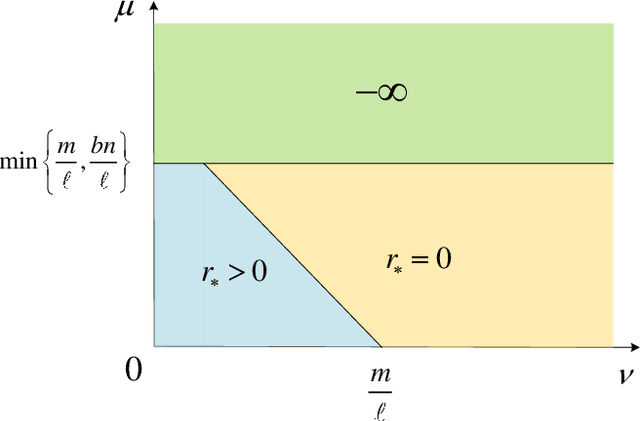


Abstract:An unsolved issue in widely used methods such as Support Vector Data Description (SVDD) and Small Sphere and Large Margin SVM (SSLM) for anomaly detection is their nonconvexity, which hampers the analysis of optimal solutions in a manner similar to SVMs and limits their applicability in large-scale scenarios. In this paper, we introduce a novel convex SSLM formulation which has been demonstrated to revert to a convex quadratic programming problem for hyperparameter values of interest. Leveraging the convexity of our method, we derive numerous results that are unattainable with traditional nonconvex approaches. We conduct a thorough analysis of how hyperparameters influence the optimal solution, pointing out scenarios where optimal solutions can be trivially found and identifying instances of ill-posedness. Most notably, we establish connections between our method and traditional approaches, providing a clear determination of when the optimal solution is unique -- a task unachievable with traditional nonconvex methods. We also derive the {\nu}-property to elucidate the interactions between hyperparameters and the fractions of support vectors and margin errors in both positive and negative classes.
Location and Map-Assisted Wideband Phase and Time Calibration Between Distributed Antennas
Oct 30, 2024Abstract:Distributed massive multiple-input multiple-output networks utilize a large number of distributed access points (APs) to serve multiple user equipments (UEs), offering significant potential for both communication and localization. However, these networks require frequent phase and time calibration between distributed antennas due to oscillator phase drifts, crucial for reciprocity-based coherent beamforming and accurate localization. While this calibration is typically performed through bi-directional measurements between antennas, it can be simplified to unidirectional measurement under perfect knowledge of antenna locations. This paper extends a recent phase calibration narrowband line-of-sight (LoS) model to a phase and time calibration wideband orthogonal frequency division multiplexing model, including both LoS and reflection paths and allowing for joint phase and time calibrations. We explore different scenarios, considering whether or not prior knowledge of antenna locations and the map is available. For each case, we introduce a practical maximum likelihood estimator and conduct Cramer-Rao lower bound (CRLB) analyses to benchmark performance. Simulations validate our estimators against the CRLB in these scenarios.
Uplink Cell-Free Massive MIMO OFDM with Phase Noise-Aware Channel Estimation: Separate and Shared LOs
Oct 24, 2024



Abstract:Cell-free massive multiple-input multiple-output (mMIMO) networks enhance coverage and spectral efficiency (SE) by distributing antennas across access points (APs) with phase coherence between APs. However, the use of cost-efficient local oscillators (LOs) introduces phase noise (PN) that compromises phase coherence, even with centralized processing. Sharing an LO across APs can reduce costs in specific configurations but cause correlated PN between APs, leading to correlated interference that affects centralized combining. This can be improved by exploiting the PN correlation in channel estimation. This paper presents an uplink orthogonal frequency division multiplexing (OFDM) signal model for PN-impaired cell-free mMIMO, addressing gaps in single-carrier signal models. We evaluate mismatches from applying single-carrier methods to OFDM systems, showing how they underestimate the impact of PN and produce over-optimistic achievable SE predictions. Based on our OFDM signal model, we propose two PN-aware channel and common phase error estimators: a distributed estimator for uncorrelated PN with separate LOs and a centralized estimator with shared LOs. We introduce a deep learning-based channel estimator to enhance the performance and reduce the number of iterations of the centralized estimator. The simulation results show that the distributed estimator outperforms mismatched estimators with separate LOs, whereas the centralized estimator enhances distributed estimators with shared LOs.
Integrated Communication, Localization, and Sensing in 6G D-MIMO Networks
Mar 28, 2024



Abstract:Future generations of mobile networks call for concurrent sensing and communication functionalities in the same hardware and/or spectrum. Compared to communication, sensing services often suffer from limited coverage, due to the high path loss of the reflected signal and the increased infrastructure requirements. To provide a more uniform quality of service, distributed multiple input multiple output (D-MIMO) systems deploy a large number of distributed nodes and efficiently control them, making distributed integrated sensing and communications (ISAC) possible. In this paper, we investigate ISAC in D-MIMO through the lens of different design architectures and deployments, revealing both conflicts and synergies. In addition, simulation and demonstration results reveal both opportunities and challenges towards the implementation of ISAC in D-MIMO.
Time vs. Frequency Domain DPD for Massive MIMO: Methods and Performance Analysis
Feb 26, 2024
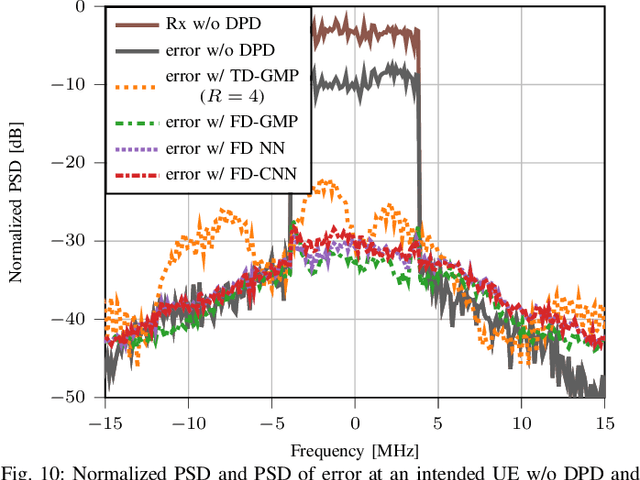
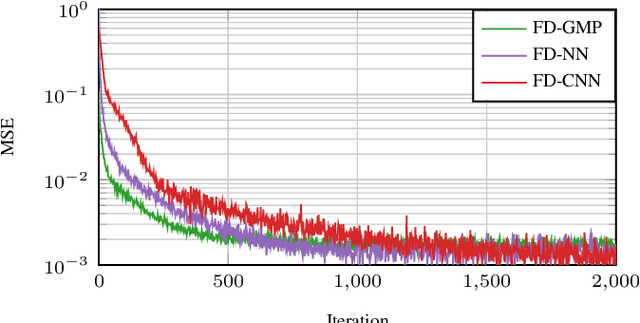
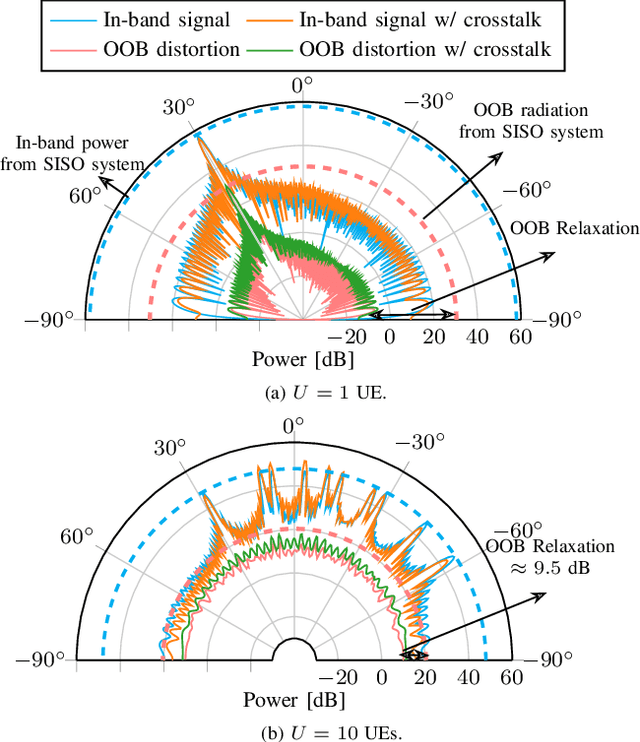
Abstract:The use of up to hundreds of antennas in massive multi-user (MU) multiple-input multiple-output (MIMO) orthogonal frequency division multiplexing (OFDM) poses a complexity challenge for digital predistortion (DPD) aiming to linearize the nonlinear power amplifiers (PAs). While the complexity for conventional time domain (TD) DPD scales with the number of PAs, frequency domain (FD) DPD has a complexity scaling with the number of user equipments (UEs). In this work, we provide a comprehensive analysis of different state-of-the-art TD and FD-DPD schemes in terms of complexity and linearization performance in both rich scattering and line-of-sight (LOS) channels. We also propose a novel low-complexity FD convolutional neural network (CNN) DPD. The analysis shows that FD-DPD, particularly the proposed FD CNN, is preferable in LOS scenarios with few users, due to the favorable trade-off between complexity and linearization performance. On the other hand, in scenarios with more users or isotropic scattering channels, significant intermodulation distortions among UEs degrade FD-DPD performance, making TD-DPD more suitable.
Impact of Phase Noise on Uplink Cell-Free Massive MIMO OFDM
May 21, 2023Abstract:Cell-Free massive MIMO networks provide huge power gains and resolve inter-cell interference by coherent processing over a massive number of distributed instead of co-located antennas in access points (APs). Cost-efficient hardware is preferred but imperfect local oscillators in both APs and users introduce multiplicative phase noise (PN), which affects the phase coherence between APs and users even with centralized processing. In this paper, we first formulate the system model of a PN-impaired uplink Cell-Free massive MIMO orthogonal frequency division multiplexing network, and then propose a PN-aware linear minimum mean square error channel estimator and derive a PN-impaired uplink spectral efficiency expression. Numerical results are used to quantify the spectral efficiency gain of the proposed channel estimator over alternative schemes for different receiving combiners.
Blind Channel Equalization Using Vector-Quantized Variational Autoencoders
Feb 22, 2023
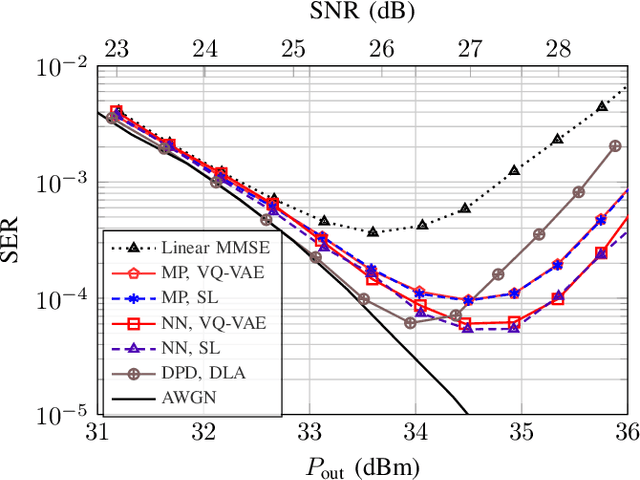


Abstract:State-of-the-art high-spectral-efficiency communication systems employ high-order modulation formats coupled with high symbol rates to accommodate the ever-growing demand for data rate-hungry applications. However, such systems are more vulnerable to linear and nonlinear transmission impairments, and it is important to mitigate the performance loss via digital signal processing. In this paper, we propose a novel machine learning approach for blind channel equalization and estimation using the vector quantized (VQ) \ac{VAE} framework. The proposed approach generalizes the applicability of the conventional \ac{VAE}-based equalizer to nonlinear systems employing high-order modulation formats by introducing a codebook component and an associated novel loss function. We evaluate the performance of the proposed method over a linear additive white Gaussian noise channel with intersymbol interference and two nonlinear scenarios. Simulation results show that the proposed method can achieve similar performance as a data aided equalizer using the \acf{MMSE} criterion, and outperforms the blind\ac{CMA} and the \ac{VAE}-based channel equalizer. Furthermore, we show that for the linear channel, the proposed scheme exhibits better convergence properties than the \ac{MMSE}-based, the \ac{CMA}-based, and the \ac{VAE}-based equalizers in terms of both convergence speed and robustness to variations in training batch size and learning rate.
Spatial Signal Design for Positioning via End-to-End Learning
Sep 26, 2022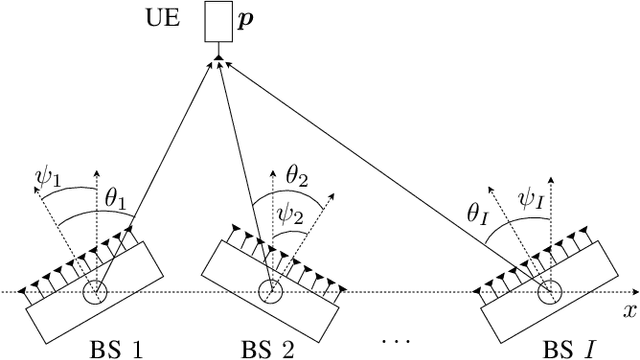
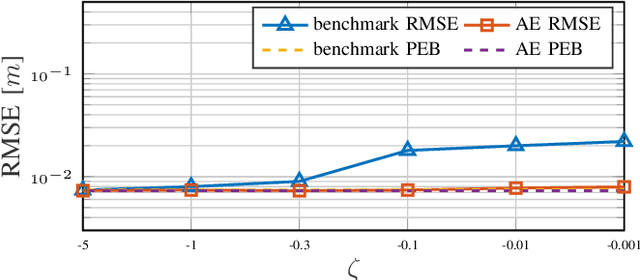

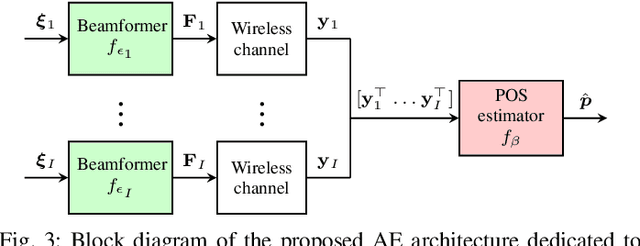
Abstract:This letter considers the problem of end-to-end learning for joint optimization of transmitter precoding and receiver processing for mmWave downlink positioning. Considering a multiple-input single-output (MISO) scenario, we propose a novel autoencoder (AE) architecture to estimate user-equipment(UE) position with multiple base-stations (BSs) and demonstrate that end-to-end learning can match model-based design, both for angle of departure (AoD) and position estimation, under ideal conditions without model deficits and outperform it in the presence of hardware impairments.
Frequency-domain digital predistortion for Massive MU-MIMO-OFDM Downlink
May 10, 2022Abstract:Digital predistortion (DPD) is a method commonly used to compensate for the nonlinear effects of power amplifiers (PAs). However, the computational complexity of most DPD algorithms becomes an issue in the downlink of massive multi-user (MU) multiple-input multiple-output (MIMO) orthogonal frequency division multiplexing (OFDM), where potentially up to several hundreds of PAs in the base station (BS) require linearization. In this paper, we propose a convolutional neural network (CNN)-based DPD in the frequency domain, taking place before the precoding, where the dimensionality of the signal space depends on the number of users, instead of the number of BS antennas. Simulation results on generalized memory polynomial (GMP)-based PAs show that the proposed CNN-based DPD can lead to very large complexity savings as the number of BS antenna increases at the expense of a small increase in power to achieve the same symbol error rate (SER).
MCRB-based Performance Analysis of 6G Localization under Hardware Impairments
Apr 27, 2022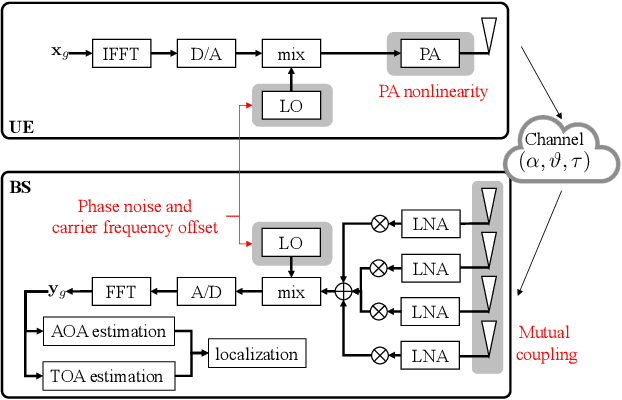
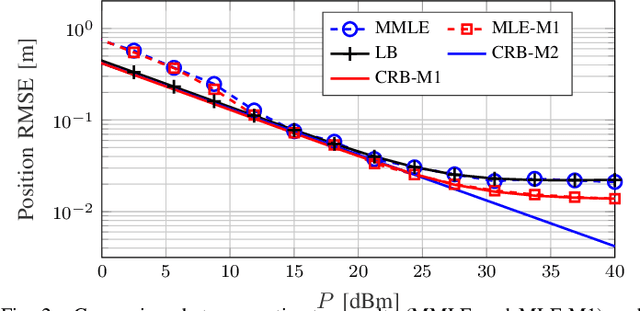
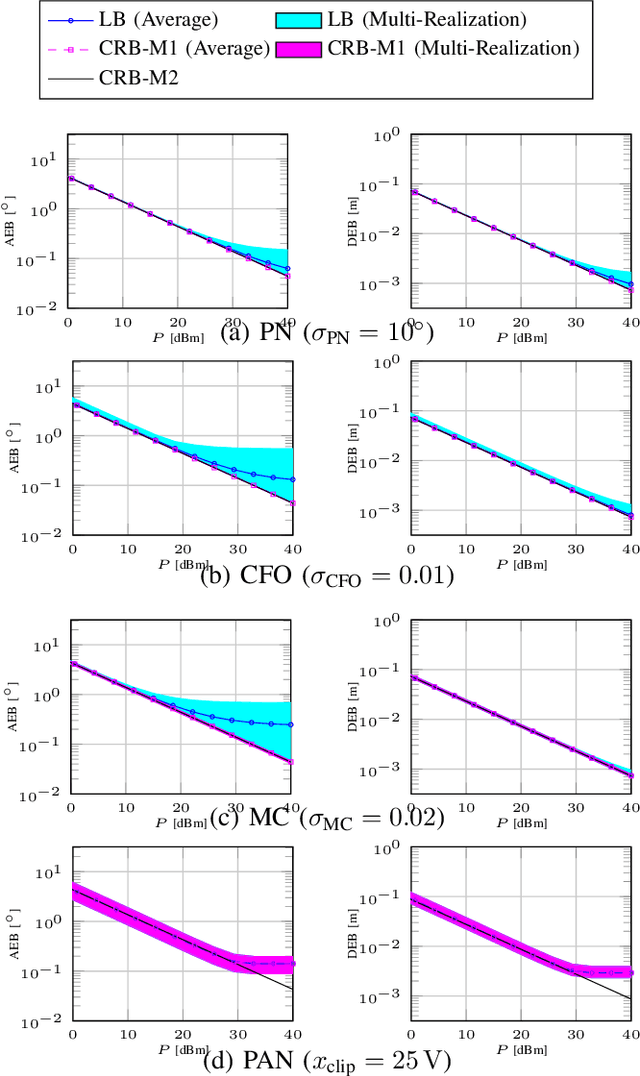
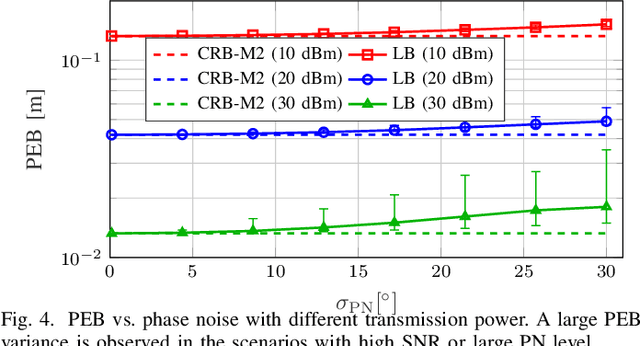
Abstract:Location information is expected to be the key to meeting the needs of communication and context-aware services in 6G systems. User localization is achieved based on delay and/or angle estimation using uplink or downlink pilot signals. However, hardware impairments (HWIs) distort the signals at both the transmitter and receiver sides and thus affect the localization performance. While this impact can be ignored at lower frequencies where HWIs are less severe, modeling and analysis efforts are needed for 6G to evaluate the localization degradation due to HWIs. In this work, we model various types of impairments and conduct a misspecified Cram\'er-Rao bound analysis to evaluate the HWI-induced performance loss. Simulation results with different types of HWIs show that each HWI leads to a different level of degradation in angle and delay estimation performance.
 Add to Chrome
Add to Chrome Add to Firefox
Add to Firefox Add to Edge
Add to Edge